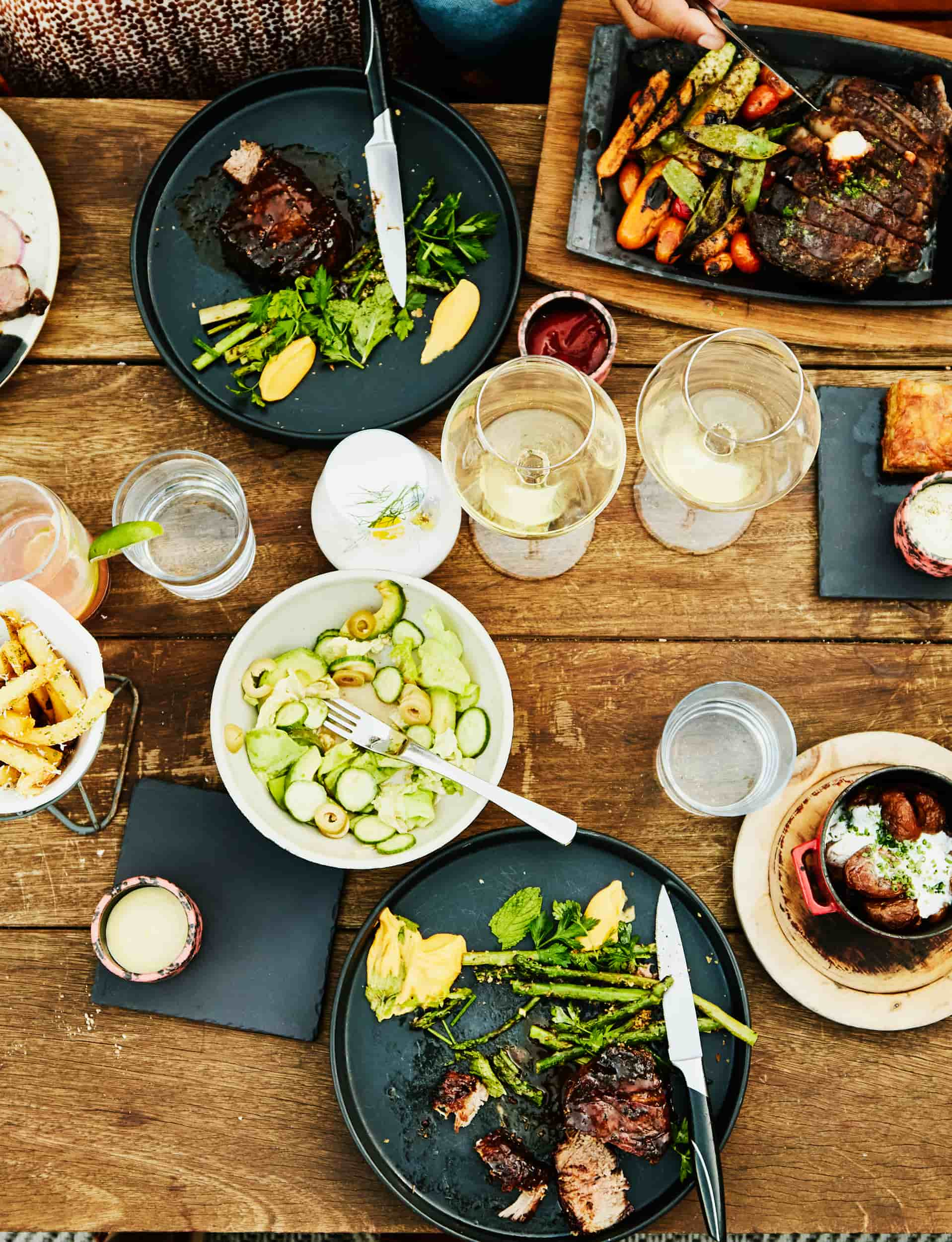


As an integral part of the hospitality industry, the food and beverage sector constantly evolves to cater to ever-changing needs, preferences, and culinary desires. In this article, we will examine aspects of the latest trends ranging from healthy eating habits and plant-based diets to groundbreaking innovations in food technology.
So get ready for a unique journey through exciting developments in taste and nutrition. If you’d like to do some further reading, you can also learn more about general hospitality trends.
Overview of Food and Beverage Trends
Let’s examine the ever-evolving world of food and beverages, where tradition meets thrilling innovation. In this dynamic territory, sizzling food trends are driven by changing consumer preferences, tastes and the emergence of new ingredients, all while prioritizing health and ethical considerations.
There are three major movements currently shaping the industry. First, a rising demand for health-conscious options reflects consumers’ growing interest in organic, gluten-free, and plant-based choices. Secondly, sustainability is moving to center stage as more people embrace the importance of the farm-to-table approach and develop a deep appreciation for environmental preservation. Finally, there has been a surge in curiosity about authentic regional flavors and global cuisines.
In addition to this, technological advances are significantly affecting online delivery services and meal kit offerings.
Be a tastemaker
The scope for what you can achieve in food and beverage is limited only by your imagination, so launch your career by learning from the best with us.
Bachelor’s of hospitality management
Healthy Eating Trends
The food and beverage industry has witnessed a notable trend towards healthier eating habits. Consumers are becoming more mindful of their well-being and the effect of good nutrition on their health, leading to significant changes in the market.
The focus on calories has shifted as many people now prioritize nourishment and the quality of nutrients in their meals. To further explore this trend, it’s important to examine key patterns that influence the current industry.
- Clean Labels: Emerging food products lean more toward natural elements as everyone wants to understand exactly what is in the food they eat.
- Functional Foods: These are foods that provide benefits beyond basic nutrition, aiding in areas such as boosting the immune system or improving gut health.
- Nutritious Snacks: There is a rise in healthy snacks that offer both nutrition and convenience packaged together.
- Hydration Innovation: Beverage trends are focusing heavily on providing hydration with added wellness benefits like electrolyte-infused water and drinks packed with vitamins or antioxidants.
Organic Food and Beverage Trends
Consumers perceive organic products favorably, not only for their potential health benefits but also because of their positive environmental impact. By choosing organic, consumers demonstrate a commitment to sustainable living.
Transparency is a crucial factor driving the increase in organic consumption. In today’s world, consumers are more diligent in reading labels and are therefore demanding clear and comprehensive information about the ingredients and methods used by food producers.
The popularity of organic foods goes beyond being a temporary trend. It is part of a larger movement towards sustainable living and prioritizing wellness. Despite their higher price tag, organic foods show great potential for future developments in the food and beverage industry.
Vegan and Vegetarian Food and Beverage Trends
One of the most noticeable and influential trends in the food and beverage industry today is the growing popularity of veganism and vegetarianism. This shift towards plant-based eating has led to a wide range of vegetarian and vegan products becoming more readily available in mainstream markets, offering greater options for individuals who choose to focus on plant-based diets. However, this movement is no longer solely focused on simply replacing meat. It now encompasses a broader aim of creating sustainable and nutritious foods that are delicious as well.
The beverage industry has also seen its share of popular trends. People who avoid dairy products have found a new favorite in iced coffee with oat milk, while craft beer brands are now proudly labeling their products as “vegan” to cater to the growing market segment.
Here are a few noteworthy breakthroughs.
- Lab-grown “Meat”: This emerging technology is advancing with the goal of offering sustainable alternatives to conventional livestock farming.
- Plant-Based Foods: You may be familiar with plant-based proteins, such as the popular brands Beyond Meat and Impossible Foods. These companies have developed burgers that closely resemble beef in appearance, texture, and taste to respond to the demand for plant-based meat substitutes.
- Dairy-Free Delights: Dairy alternatives like almond cheese and coconut yogurt have become increasingly popular, reflecting a growing demand from consumers.
Gluten-Free Food and Beverage Trends

Gluten-free foods continue to be a prominent sector in the ever-evolving world of food and beverage preferences. With a significant global population affected by gluten sensitivity and celiac disease, this trend remains significant.
The popularity of gluten-free products is not limited to those with health concerns. Many individuals who are striving for healthier eating habits have embraced this way of eating. According to reliable sources, the consumption of gluten-free products has experienced significant growth in recent years, indicating a promising future for brands entering this market.
Sustainable Food and Beverage Trends
The reduction of waste has become a significant topic in the food and beverage industry, especially among conscious consumers who are seeking more eco-friendly options. One innovative solution gaining traction is edible packaging, which helps to decrease plastic waste.
Regenerative agriculture, another rising movement in the food industry, is guiding the sector towards a more sustainable path. This farming technique prioritizes topsoil regeneration, biodiversity enhancement, ecological integrity promotion, and carbon sequestration. The result is nutrient-rich crops that align with both our palate and environmental values.
Efforts to reduce water waste are gaining momentum. Mindful restaurants are implementing water-saving technologies, demonstrating the importance placed on sustainability in the dining industry.
Farm to Table Food and Beverage Trends
The growing popularity of the farm-to-table movement in the food and beverage industry cannot be underestimated. This significant development highlights a renewed emphasis on obtaining fresh ingredients from local farms and wastes nothing.
The philosophy behind this growing trend is straightforward yet revolutionary. Serving locally sourced, environmentally-friendly food not only promotes consumer health but also boosts local economies. By connecting farmers directly with consumers, it fosters transparency within the entire supply chain.
- Locality: One of the key characteristics of farm-to-table establishments is their partnership with local agricultural enterprises to directly source ingredients.
- Seasonality: Instead of relying on international imports, these initiatives take advantage of seasonal produce.
- Sustainability: Sustainability is a central focus of this vision, prioritizing farming practices that minimize harm to our environment and lower the carbon footprint of the food and beverage sector.
Ethnic Cuisines and Fusion Cuisine Food and Beverage Trends
Another key aspect that stands out in an examination of today’s food and beverage trends is the growing popularity of ethnic cuisines and fusion dishes. Expanded travel opportunities, greater cultural blending, and a heightened appreciation for diversity have all played significant roles in shaping our culinary preferences.
Ethnic flavors offer a tantalizing experience with their unique spices, authentic ingredients, and distinct cooking techniques. Today’s consumers are becoming more adventurous in their dining choices, eager to explore new and unfamiliar culinary territories. Recent studies in the food and beverage industry reveal that diners are expanding their culinary horizons beyond traditional European cuisine, embracing lesser-known dishes from Asia, Africa, the Middle East, and Latin America.
Another trend in cuisine is the combination of different regional flavors through fusion cooking. This showcases the creativity of skilled chefs who combine traditional recipes from multiple cultures to create innovative and avant-garde dishes. This technique, popularized by Wolfgang Puck in late 20th-century California, has now become a staple in contemporary gastronomy. Today’s culinary innovators are crafting unique creations like Korean tacos, which merge South-Korean bulgogi with Mexican tortillas, or sushi burritos that marry Japanese sushi with burrito fillings.
Food Delivery Services: Food and Beverage Trends
The rise of digital platforms has revolutionized how we consume food and beverages, leading to a notable shift in dining habits. Online ordering and home delivery services have emerged as influential trends, disrupting traditional dining experiences. This transformation, accelerated by the pandemic, has transformed restaurant food from a social experience into a convenient option that can be enjoyed within the comfort of our own homes.
Meal Kits Food and Beverage Trends
Imagine the convenience of receiving a box filled with perfectly portioned, chef-selected ingredients delivered right to your door. This is the essence of the meal kit trend. In our fast-paced lives, time is incredibly valuable. To juggle healthy eating and easy meal preparation, meal kits have become increasingly popular.
Craft Beer, Wine, and Spirits Food and Beverage Trends
Craft beers, wines, and spirits are undergoing a creative transformation when it comes to food and beverage trends. A surge of innovation has swept this industry, giving rise to distinctive flavor profiles that captivate those seeking novel taste experiences.
Craft beer has been steadily gaining popularity in beverage trends, reflecting a broader move in the beverage industry towards artisanal production methods over mass-produced alternatives. This preference goes beyond simply consuming alcohol. It is now all about connecting with a story — the unique history behind each brew.
In the world of wine, small vineyards that cultivate distinctive heritage grapes have captured attention. The emergence of natural wine pairings has added a special allure to both informal gatherings and upscale dining experiences.
The spirits industry is undergoing a noticeable shift towards embracing experimental distilleries with boutique gin becoming extremely popular. Beverage companies are now exploring new methods such as incorporating locally foraged botanicals into gin or aging whiskey in wine barrels, pushing the boundaries of traditional practices and flavors.
Get the taste for success
Combining insights from industry leaders with opportunities to expand networks in sought-after professional placements, this degree is the ultimate choice to savour the world of food and beverage at the highest level.
Masters in hospitality
Conclusion
It’s clear that innovation and catering to consumer demands are at the forefront of current food and beverage developments. From new and exciting culinary creations to the industry accommodating dietary preferences, these trends offer valuable insights into what lies ahead for dining experiences worldwide.
As the food and beverage industry continues to evolve, it’s important to stay aware of emerging markets for vegan and vegetarian products, gluten-free options, and a focus on organic ingredients. Regional flavors are also gaining popularity. If you’re interested in pursuing an exciting career in food and beverage management, then start your journey with a hospitality degree from Glion. Or, find out about even more reasons to work in hospitality.
Photo Credits
Main Image: Thomas Barwick/ Photograph via Getty Images
















